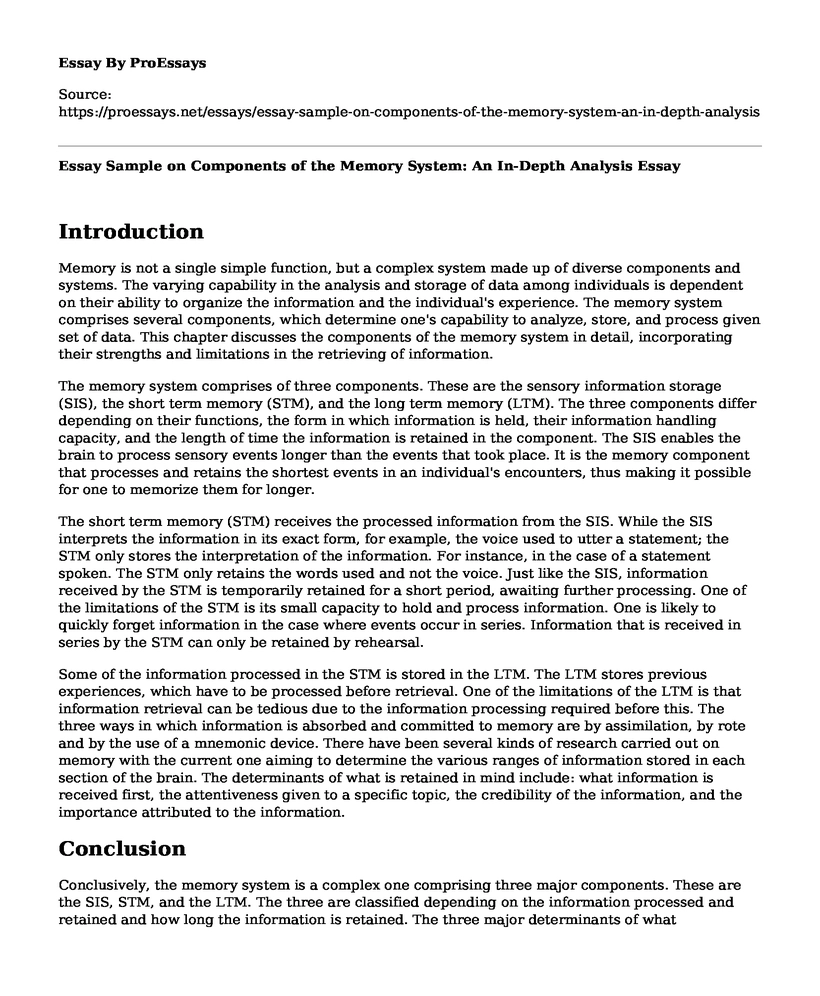Introduction
Memory is not a single simple function, but a complex system made up of diverse components and systems. The varying capability in the analysis and storage of data among individuals is dependent on their ability to organize the information and the individual's experience. The memory system comprises several components, which determine one's capability to analyze, store, and process given set of data. This chapter discusses the components of the memory system in detail, incorporating their strengths and limitations in the retrieving of information.
The memory system comprises of three components. These are the sensory information storage (SIS), the short term memory (STM), and the long term memory (LTM). The three components differ depending on their functions, the form in which information is held, their information handling capacity, and the length of time the information is retained in the component. The SIS enables the brain to process sensory events longer than the events that took place. It is the memory component that processes and retains the shortest events in an individual's encounters, thus making it possible for one to memorize them for longer.
The short term memory (STM) receives the processed information from the SIS. While the SIS interprets the information in its exact form, for example, the voice used to utter a statement; the STM only stores the interpretation of the information. For instance, in the case of a statement spoken. The STM only retains the words used and not the voice. Just like the SIS, information received by the STM is temporarily retained for a short period, awaiting further processing. One of the limitations of the STM is its small capacity to hold and process information. One is likely to quickly forget information in the case where events occur in series. Information that is received in series by the STM can only be retained by rehearsal.
Some of the information processed in the STM is stored in the LTM. The LTM stores previous experiences, which have to be processed before retrieval. One of the limitations of the LTM is that information retrieval can be tedious due to the information processing required before this. The three ways in which information is absorbed and committed to memory are by assimilation, by rote and by the use of a mnemonic device. There have been several kinds of research carried out on memory with the current one aiming to determine the various ranges of information stored in each section of the brain. The determinants of what is retained in mind include: what information is received first, the attentiveness given to a specific topic, the credibility of the information, and the importance attributed to the information.
Conclusion
Conclusively, the memory system is a complex one comprising three major components. These are the SIS, STM, and the LTM. The three are classified depending on the information processed and retained and how long the information is retained. The three major determinants of what information is received and retained include the importance of the information, the information retained first, and the attentiveness given to the information.
Cite this page
Essay Sample on Components of the Memory System: An In-Depth Analysis. (2023, Mar 27). Retrieved from https://proessays.net/essays/essay-sample-on-components-of-the-memory-system-an-in-depth-analysis
If you are the original author of this essay and no longer wish to have it published on the ProEssays website, please click below to request its removal:
- Paper Example on Important Aspects of the Performance Management System
- The Theme of Eating in Alice's Adventures in Wonderland - Essay Sample
- Individual Development Plan for a Skill I Wish to Enhance in Myself
- Essay Sample on Body Image & Photo Manipulation: Understanding Society's Standards
- Essay Sample on Love and Hatred: Significant Factors in an Individual's Life
- Essay Example on Savannah's Struggle: A Tale of Stress & Overwhelm
- Essay Example on Effect of Psychotherapy on Recovery from Depression







